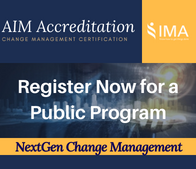Don Harrison, the developer of the AIM Change Management Methodology, has spent his 40+ year career working with global organizations on how to implement complex change. He specializes in delivering tough messages to senior executives on their role as Sponsors. Not an easy task! 
This year, Don’s been talking to change management professionals about the need to shift from the traditional “doing change management” to Next Generation Change Management, where the limited resources available for implementation are specifically targeted for maximum impact to drives business value. Below, in his own “tell-it-like-it-is” style, he answers the most common questions he receives on how change management professionals need to shift to impact based, Next Generation Change Management to lead to benefit realization.
Q: Our organization seems to be in a constant state of change. How does the AIM change management methodology deal with change fatigue?
A: I think we can all agree we’ve never experienced a rate of organizational change like we are experiencing today. There is simply no rest from the barrage of projects disrupting past habits, patterns and ways of working. This constant state of transition is most certainly creating an unprecedented level of organizational stress and, in turn, an overwhelming sense of change fatigue.
But in the end, change fatigue is simply a culturally acceptable form of resistance. As change management professionals, we need to be able to surface the resistance, understand it and then manage it. Yes, there is way too much going on in almost every organization. Still, my first recommendation is not to talk to your Sponsors about setting priorities, because most of the time Sponsors think everything is important! Instead, talk about project sequence; what should come first, second, and third.
Secondly, you need to change your thinking from how to succeed in your current project to how to increase your organization’s overall capacity for implementation. Becoming “Change Adept” takes more than AIM, even though it is the most business outcome focused framework out there. It also requires the ability to drive innovation, a project management methodology and demonstrated leader commitment.
Q: From your own consulting work, do you have a suggestion on what to say to Leaders to get their buy in?
A: For goodness sake, do NOT talk about change management! If you do, you will see their eyes immediately glaze over. Sponsors do not want to hear about managing Resistance, building Readiness or your Communication plan. What they do want to talk about is how the project is going to get done faster, cheaper and at a higher quality. These three factors are the universal motivation for Sponsors. I always say, “When you go to France, you need to speak French. So when you go to Sponsor-land, you need to speak the language of Sponsors.” In other words, you need to speak to them in their Frame of Reference. Also, be sure when you ask your Sponsor to do something for the project, you are making your Sponsor look good. For example, if your Sponsor isn’t good at public speaking, having them lead a town hall meeting is not a good idea. This is how you build trust. And trust is the most important thing in building a relationship with your Sponsor.
Q: How do you convince Sponsors to be active through the entire life of a project?
A: This is a great question, because more often than not, Sponsors think their role ends once the project is launched. But getting to launch is the easy part of a project. Senior leaders must maintain laser focus on the implementation over the entire life cycle of the project (especially when things are going off the rails and aren’t looking so good!) Once the change is designed, your executives can’t step out and expect others to make the change happen “out there.” They need to be active and visible, and continue to Express, Model and Reinforce their public and personal commitment to the change.
How do you do you ensure your Sponsors are doing what is required? In our AIM Accreditation program, I spend a lot of time teaching Sponsor Contracting. In my experience, it’s the most important skill a Change Agent needs to have. Sponsor contracting is the process by which Change Agents and Sponsors exchange their offers, wants and needs. The process is cyclical, iterative and must occur periodically so that Sponsors are constantly aware of what is expected of them during the entire life of the project--not just at launch.
Q: How do you measure change management success?
A: It sounds quite obvious, but the end goal of every change project needs to be full value realization. But, so many projects get to the go-live or cut-over date and are declared complete and, thus, successful. I like to call this “premature project completion,” because the truth is, getting to go-live has nothing to do with implementation. Sure, the project may look complete, but there is no change until you get to sustained behavior change and that doesn’t happen at launch! There are 5 metrics that must be met on every project to deem it “successful:”
- It’s delivered on time
- It’s delivered on budget
- The technical objectives are achieved
- The business objectives are achieved
- AND it meets the human objectives that have been established for the change
The human objectives of a change are what the Targets of the change will be doing differently in the future state as a result of the change. Even though more emphasis is typically placed on strategy development, getting strategy right represents only 15% of the job. 85% of your success depends on how the organization implements that strategy. Too often, there is far greater financial investment in the achievement of an initiative’s business and technical objectives compared to the investment in achieving the human objectives. But the fact is, all five measures must be achieved to achieve full Return on Investment and to call a change successful.
If you are accountable for change implementation, don’t let shifting to Next Generation Change Management intimidate you. We tell our clients all the time the most effective way to “change change management” is not at the enterprise, cultural level. Instead, change what you do one project at a time. It’s a much narrower approach that means selecting 3 or 4 actions that will have a significant impact on value realization for that project. As a Next Generation Change Agent, you can begin to change project results when you change what you spend your time on. Leaders will start to notice when projects go differently and you can then build from there.
To join the more than 3,000 people worldwide who’ve been certified in Next Generation Change Management, register now for an AIM Accreditation session led by Don Harrison.


